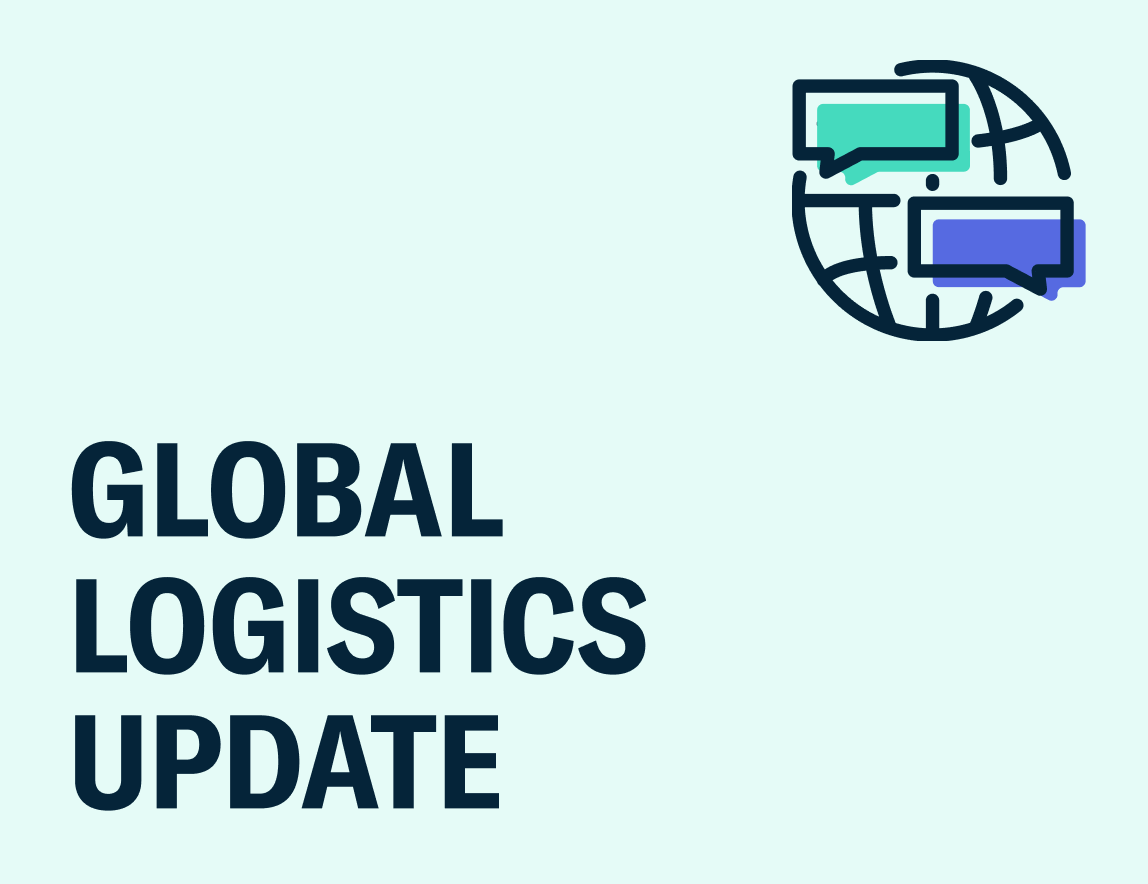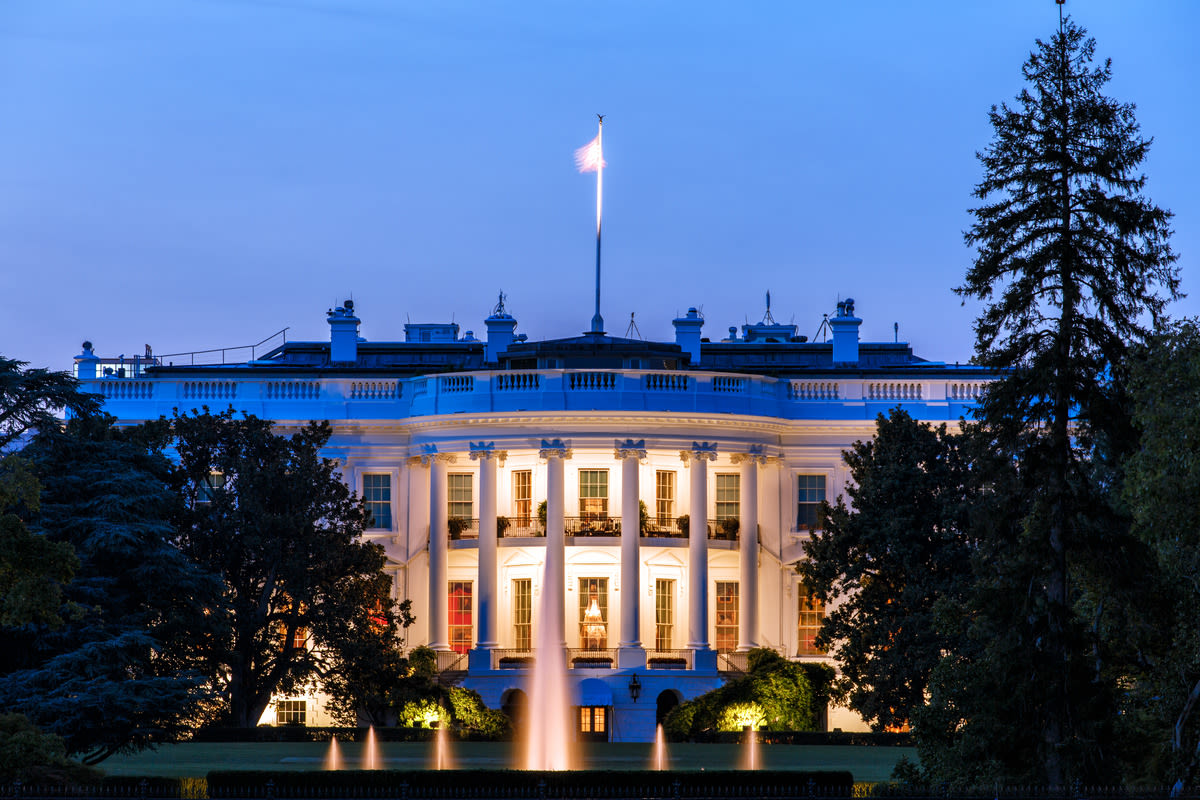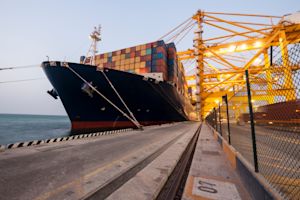
Global Logistics Update
Supreme Court Hears Arguments on IEEPA Case; Ex-China Air Market Begins to Stabilize
Updates from the global supply chain and logistics world | November 6, 2025
Global Logistics Update: November 6, 2025

November 6, 2025
Trends to Watch
Talking Tariffs
- International Emergency Economic Powers Act (IEEPA) Tariff Case Developments: Yesterday (November 5), the U.S. Supreme Court heard oral arguments on the legality of the Trump administration’s IEEPA tariffs. The case directly covers IEEPA “fentanyl” tariffs on China, Canada, and Mexico, along with IEEPA reciprocal tariffs imposed by President Trump’s April 2 and July 31 executive orders. The case does not directly cover Section 232 tariffs, Section 301 tariffs, the additional 40% IEEPA tariff on Brazil implemented on August 6, or the 25% IEEPA “oil” tariff on India implemented on August 27.
- During yesterday’s hearing, several justices challenged the Trump administration’s assertion that the tariffs in question aim to “regulate importation” in response to rising trade deficits and a fentanyl-induced public health crisis. Justice Sonia Sotomayor in particular contended that these tariffs are ultimately taxes that generate revenue from American citizens.
- Another point of contention in yesterday’s arguments: the process of refunding more than $90 billion in already-collected duties, should the Court rule against the Trump administration's tariffs. Justice Amy Coney Barrett raised concerns over how the refund process would work, and whether it would be “a complete mess.”
- The Supreme Court will likely take at least a few months to reach a decision. It’s possible that the Court will announce its decision at the end of its term next year, right before the justices’ summer break.
- If the Supreme Court rules against the Trump administration’s tariffs, U.S. Customs and Border Protection (CBP) would halt duty collection immediately while implementing a refund process. However, it is unclear how much discretion the court order would give CBP in how it can issue refunds, or if the justices would first determine which importers are eligible for refunds. Additionally, if the Court does strike down the tariffs in question, the Trump administration could potentially turn to other statutes—like Sections 301, 232, or 122—to re-implement those tariffs or introduce new ones.
- If the Supreme Court upholds the tariffs, on the other hand, the case could potentially return to the lower courts for another review of certain aspects of the case.
- Check out our live blog for more details and the latest developments.
- U.S.-China Trade Developments: After last week’s meeting between President Trump and President Xi, the U.S. and China will soon begin implementing certain measures:
- Effective November 10, 2025, the U.S. will reduce its “fentanyl” tariff on China from 20% to 10%. Meanwhile, the U.S. will keep in place its existing 10% reciprocal tariff rate on China until November 10, 2026. This means that the combined effective duty rate on China will soon be approximately 45%: a 10% reciprocal tariff, a 10% “fentanyl” tariff, and up to 25% in Section 301 tariffs.
- The U.S. will keep in place certain Section 301 tariff exclusions, previously due to expire on November 29, 2025, until November 10, 2026.
- On November 10, 2025, the U.S. will suspend its recently implemented port fees on Chinese vessels for one year. China has also pledged to suspend its retaliatory port fees on American vessels for one year, though it is unclear when that one-year period will commence.
- China agreed to suspend retaliatory tariffs and non-tariff countermeasures against the U.S. implemented since March 4, 2025.
- China also agreed to suspend the global implementation of its latest rare earth export controls. China will also issue general export licenses for certain rare earth metals that will benefit U.S. end-users and their suppliers, which means “the de facto removal of controls China imposed in April 2025 and October 2022.”
- China will purchase at least 12 million metric tons of U.S. soybeans in the last two months of 2025, and at least 25 million metric tons each year between 2026 and 2028. China will also resume purchases of U.S. sorghum and hardwood logs.
- Other Recent Updates:
- As of last Saturday (November 1), medium- and heavy-duty trucks (MHDVs) are subject to a 25% tariff, and buses and other vehicles classified under HTSUS heading 8702 are subject to a 10% tariff. Importers of USMCA-compliant MHDVs may submit documentation detailing the amount of U.S. content in each truck, and pay the 25% tariff only on non-U.S. content. Additionally, as is the case with auto tariffs, imports subject to MHDV tariffs are exempt from other Section 232 tariffs (steel, aluminum, copper, and timber), as well as IEEPA tariffs (reciprocal, “fentanyl” on Canada/Mexico, and other levies).
- CBP updates: On October 30, CBP implemented an automated application process for new ACE Portal accounts, streamlining access to users’ import activities, entries, payments, and compliance data. And beginning December 15, Periodic Monthly Statement (PMS) test participants will be required to pay all supplemental duty bills electronically. Check out our blog to learn more about these changes, including how Flexport can assist with critical action items.
- On October 29, the U.S. and South Korea finalized the key terms of a trade deal, under which the U.S. will reduce the reciprocal tariff rate on South Korean goods from 25% to 15%. Additionally, South Korea will invest up to $20 billion in cash each year in the U.S. economy, and $150 billion in the U.S. shipbuilding industry.
- On October 26, President Trump signed new trade deals with Malaysia and Cambodia, while announcing frameworks for new deals with Thailand and Vietnam. Under these agreements, the U.S.’s reciprocal tariff rate for each of the four nations will remain in place. Meanwhile, all four nations will remove many tariff and non-tariff barriers on U.S. exports, and ramp up purchases of U.S. aerospace, energy, and agriculture products.
Calculate your tariff and landed cost impacts in real time with the Flexport Tariff Simulator.
Ocean
TRANS-PACIFIC EASTBOUND (TPEB)
- Capacity and Demand:
- Capacity has rebounded for November, with all gateways to the U.S. experiencing a 10-15% increase in available capacity. Overall TPEB capacity is expected to remain between 83-88% throughout the month.
- Demand for container space remains healthy heading into November, following the rush of bookings related to the previously anticipated November 1 tariffs on Chinese exports to the U.S.
- Carrier vessel utilization is stronger on U.S. West Coast services than on U.S. East Coast services.
- Freight Rates:
- The November 1 General Rate Increase (GRI) has softened on all U.S. gateways.
- Carriers have not indicated a November 15 GRI at this time.
- The Peak Season Surcharge (PSS) has been further postponed to December 1.
FAR EAST WESTBOUND (FEWB)
- Capacity and Demand:
- Throughout October and heading into November, the FEWB has remained in a tenuous state between capacity injections and softening demand. Carriers have maintained blank sailings and select service suspensions to mitigate overcapacity. Meanwhile, booking activity remains moderate in light of sluggish European import demand ahead of the traditionally quiet winter months. Many carriers are now facing utilization levels hovering just above 85%, which is below the seasonal norm for November.
- Port congestion in North Europe remains a critical bottleneck, indirectly constraining available capacity. Major hubs are facing average delays of three to five days, while Rotterdam in particular is experiencing dwell times over nine days and yard utilization exceeding 90%. These operational inefficiencies have effectively reduced round-voyage frequency by up to 25–30%, tightening practical capacity despite nominal tonnage growth.
- Carriers are actively repositioning vessels and reallocating berth windows to minimize turnaround losses, but congestion is expected to persist into December due to limited labor availability and winter weather patterns.
- Freight Rates:
- Rates have recovered slightly heading into November, with Shanghai Containerized Freight Index (SCFI) levels showing gradual improvement since early October lows. The rebound is modest, largely supported by controlled capacity and congestion-induced tightening rather than genuine volume growth.
- The underlying market remains constrained. Overcapacity throughout the year continues to cap upward momentum. Most lines are prioritizing service reliability and cost efficiency over aggressive rate increases, aiming to sustain market share and profitability in a low-demand environment.
- Persistent port congestion at major North European hubs could absorb some excess capacity, potentially limiting downward pressure on rates. Barring a sharp drop in delays or a surge in blank sailings, the short-term outlook points to stable-to-soft rates.
TRANS-ATLANTIC WESTBOUND (TAWB)
- Capacity and Demand:
- Antwerp: The pilots’ strike was previously suspended amid resumed negotiations. Yard utilization is at 75%, with berth delays of two to three days.
- Rotterdam: Yard utilization is at 81-89%, with berth delays of two to three days.
- Hamburg: Yard utilization is at 75-85%, with berth delays of one to seven days.
- Bremerhaven: Yard utilization is at 75-85%, with berth delays of one to two days.
- South Mediterranean (Piraeus, Genoa, Valencia): Significant yard congestion persists, vessel wait times of three to seven days.
- Equipment:
- Container and chassis shortages in Europe remain critical, especially in Austria, Slovakia, Hungary, Southern and Eastern Germany, and Portugal. This has led to ongoing operational delays and equipment availability challenges.
- Freight Rates:
- As of early November, spot rates remain soft, generally holding around $1,800-$1,900/FEU. This is consistent with average levels reported in late October.
INDIAN SUBCONTINENT TO NORTH AMERICA
- Capacity and Demand:
- Routes from the Indian subcontinent to the U.S. remain in a tariff-escalation-induced status quo. Demand remains soft after August’s tariff escalation, and carriers are continuing to implement blank sailings to balance supply and demand.
- Capacity to the U.S. East Coast: Supply continues to outstrip demand; carriers have announced blank sailings that will take place throughout the month of November.
- Capacity to the U.S. West Coast: Capacity remains available, given supply dynamics on the TPEB into the U.S. West Coast.
- Freight Rates:
- Cargo moving to the U.S. East Coast: The market continues to hover on base lanes. Ongoing carrier capacity management has resulted in more balanced supply.
- Cargo moving to the U.S. West Coast: August’s tariff increases and oversupply on core TPEB lanes continue to keep rate levels low.
Air
- North China:
- Given the temporary U.S.-China trade deal and an ease in momentum from the electronics, ecommerce, and industrial materials sectors, the market is now returning to normal. However, the traditional peak season continues.
- Some shippers are shifting their cargo from air to ocean freight, slightly reducing air freight demand.
- Last month’s capacity pressure has begun to subside, and scheduling flexibility has improved. Overall space availability is gradually increasing, particularly for long‑haul U.S. destinations.
- The Asia‑Europe market remains consistent with past weeks: despite steady demand and tight capacity, stability has returned and the flow of bookings is becoming more predictable.
- South China:
- Export demand remains exceptionally strong across major trade lanes, particularly to Europe and North America. Ongoing preparation for large‑scale retail and ecommerce events, including Singles’ Day and Black Friday, continues to drive elevated volumes. Most flights are fully booked, and high utilization levels are expected to persist throughout the peak season.
- Shippers are strongly encouraged to confirm bookings as early as possible to secure uplift.
- Taiwan:
- The Trans-Pacific market is showing early signs of softening, while demand on Europe‑bound routes continues to surge. Increased shipments related to high technology sectors, including AI infrastructure and drone manufacturing, are pushing volumes higher.
- The overall market outlook remains upbeat for the next two weeks, and securing bookings in advance remains critical for consistent space access.
- Vietnam:
- Export demand to both the U.S. and Europe remains robust, sustaining the strong momentum of previous weeks.
- Heavy congestion continues to affect major gateway airports, with very limited space availability before mid‑November.
- In general, shippers will need to book about a week in advance to ensure uplift. Shippers are also encouraged to allow flexibility in routing due to capacity constraints and ongoing backlogs.
- Cambodia:
- Space remains constrained due to high export volumes. Capacity to both Trans-Pacific and European markets is tight, and airlines are operating near full utilization.
- Customers are advised to make reservations at least one to two weeks in advance to secure uplift, particularly for urgent or time‑sensitive shipments.
- South Korea:
- The export market continues to experience strong demand. Space for early November is filling rapidly, and bookings placed too close to departure may result in backlogs.
- Shippers are encouraged to plan early and book in advance to avoid delays.
- Malaysia:
- Volumes on key long‑haul routes to the U.S. and Europe have risen again this week. Capacity remains limited as carriers deal with increased throughput at major international hubs. Tight market conditions are expected to persist through the first half of November.
- Shippers are encouraged to secure bookings at least a week prior to departure to mitigate the risk of delays.
- Thailand:
- Market demand remains steady, but slightly lower compared to the previous week.
- However, space availability remains tight as carriers navigate strong overall utilization and end‑of‑month shipping pushes.
- Early bookings, preferably one to two weeks before departure, remain the best option to ensure space and smooth cargo flow.
- Indonesia:
- Export volumes continue to climb across both Trans-Pacific and Europe‑bound trade lanes. Airlines are reporting capacity shortages as increases in seasonal freight places further strain on available space. This trend is projected to continue into mid‑November.
- Advance coordination and bookings are essential for maintaining schedule reliability.
- India:
- Export activity across India continues to rise heading into early November, with tightening capacity on key trade lanes. Early bookings remain critical for efficient space management.
- Sri Lanka:
- Sri Lanka remains stable and space is generally manageable, although demand for U.S.-bound flights is steadily rising.
- Pakistan:
- In Pakistan, carriers are reporting capacity constraints, particularly at transshipment points where limited capacity continues to create pressure.
- Bangladesh:
- The market has seen modest improvements in cargo handling as backlogs continue to ease. However, demand is gradually rising amid the onset of the peak season.
- Congestion has eased at the main airport’s cargo terminal, but carrier capacity remains tight for last-minute bookings.
- Shippers are strongly encouraged to book earlier than usual and consolidate smaller shipments where possible to achieve smoother uplift and greater cost efficiency.
(Source: Flexport)
Please reach out to your account representative for details on any impacts to your shipments.
North America Vessel Dwell Times

Webinars
European Freight Market Update
Tuesday, November 11 @ 15:00 GMT / 16:00 CET
Tariff Trends 2025: Expert Insights on the New U.S. Customs Landscape
Wednesday, November 12 @ 9:30am PT / 12:30pm ET
North America Freight Market Update Live
Thursday, November 13 @ 9:00am PT / 12:00pm ET
Ocean Timeliness Indicator
Transit time increased from China to the U.S. West Coast, declined from China to the U.S. East Coast, and remained near-constant from China to North Europe.
Week to November 3, 2025
Transit time from China to the U.S. West Coast saw a moderate increase, rising from 33.5 to 35 days. Meanwhile, transit time from China to the U.S. East Coast decreased, dropping from 53.4 to 52 days. Finally, transit time from China to North Europe remained near-constant, rising slightly from 59.5 to 59.9 days.

See the full report and read about our methodology here.
About the Author

November 6, 2025
Related content
Ready to get started?
Learn how Flexport’s supply chain solutions can help you capture greater opportunities.






